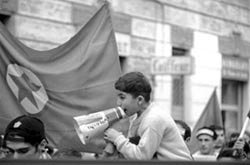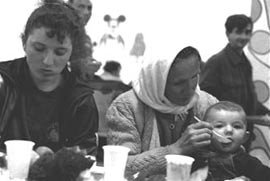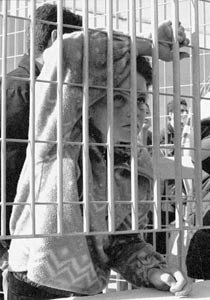


With a Camera, a Backpack, Books, and Illusions
A Letter to Narco News Readers from Manuela Aldabe in Italy
By Manuela Aldabe
2004 Narco News Authentic Journalism Scholar
June 7, 2004
Rome, June 2004
Hi. I’m 28, from Uruguay, and I live in Rome.
 To support Manuela’s scholarship, use this link. |
I like to discover and remember: I’m a photographer, and a history student.
In 1992 I began studying photography in the Visual Dimension School of Montevideo. Entering the darkroom for the first time something changed inside me forever. Here, my space, we where, as I draw the light and count one thousand, two thousand, three thousand, I dance and discover images that bloom little by little until they sign themselves on paper while I delicately move the acid to obtain the contrast that the photo deserves.
The darkroom and entire afternoons at the movies in Uruguay brought me closer to images in movement. In 1994 I met the director of TEBA (a workshop-school for bachelors of arts), who after seeing my portfolio invited me to study at the school with a scholarship, paying for my studies by working in the administration. Living at TEBA I learned the first steps of video production. It was an excellent experience (although I only took the course for one year). It was in that context where I produced my first video-clip collaborations, and my first minute of video animation. That was selected to be shown in the category of the best youth videos of the year in the International Cinema Festival of Uruguay. My first work hit the screen with the title of Abrazos (Embraces).
 Above and right: Kurds demonstrate for the freedom of Abdullah Ocalan By Manuela Aldabe |
I believe that alternative information from below is very important, and Radio Sembrando is a good example. My documentary lasted 25 minutes (I paid for the production by working in advertising), and with the help of friends (cinematographers, audio technicians, editors) we finished the work.
 |
Each day I would go out into the street to observe, at every chance to follow, a demonstration. One day there was a demonstration by Kurds. I didn’t even know who they were. I went to see what it was about: a people who called for the liberation of their leader: Abdullah Ocalan.
They were Muslims, women seated on one side, men on another, and it was difficult to communicate with them. But we did it through glances. There after a week of working, a week of permanent protest, sharing everything with them, a Kurd led me to a place and said that there I would find the information I needed to report the story. I went running and when I arrived at the door, do you know who opened it? Ocalan! The youths introduced me to him. He grasped my hands firmly. His eyes glistened. They explained to me that I could not take photos, that this was a very delicate situation. I understood. They gave me the information I needed to write my article. It was already unimportant to photograph him. I had beautiful photos of his people demonstrating, people who came from all over Europe. The tenderness that they communicated to me led me to understand that it was a humanizing moment for my reporting. Something stayed in my heart, something that would be told through my photos, the photos from the street. All of Europe and Turkey (whose police captured him one month later and he is still a prisoner today) were hunting for him, but he was there, at peace, and although I knew that photo could open the doors to my career I preferred not to take it. I preferred to offer respect.
As the immigrant that I am, the news of clandestine landings on Italian coasts cuts close to home: With Kosovo at war I could not help but get on a train, without even knowing what I was seeking, while speaking with the people I moved from train to train and arrived at Otranto, the point in southern Italy closest to Albania. There I found the Centro de Accoglienza Regina Pace, an aid center only in name. It was a center for sheltering immigrants, above all immigrants who had escaped from wars: from Kosovo, from Palestine, from Kurdistan. They didn’t let me in. They didn’t allow photographs. For two days I rambled through the town seeking permission but nobody would give it to me. It then occurred to me to present myself as a volunteer, not to take photos, but to work, to help.
 Above and right: photos from the immigrant shelter in Otranto, Italy By Manuela Aldabe |
I’ve done other reporting (about drug addiction on the streets of Rome, among other themes), but those two I just described are the ones that stayed in my soul, because if each time I look through my Nikon I learn something about others, those situations gave me humanity, a reason to do it. To photograph the eyes of an old lady who has lost everything in the war, who has only one set of clothes, her veil, and plastic bag in her hands, those eyes are a commitment to life that I can’t resign from.
 |
After two years in Italy I traveled to Berlin, where with a photographer friend we began a video-and-photo documentary project about occupations of buildings in Europe: In Berlin, in Amsterdam and in Rome. We looked at different kinds of lives, communitarian lives. For more than a year in Amsterdam I dedicated myself to film the squatters movement.
In 2001, I returned to Italy, and began a stage in the Associated Press news agency. The original job was for three months, but I stayed for a year. It was a very positive experience, above all for understanding what I want out of my photography. I felt like a photo-taking machine, without time or possibility to analyze what I was doing.
From there I enrolled in the University, majoring in Science History, studying land and international aid programs. In this I realized that, photographically, I had reached a good point, that my photos finally were publishable on the front page, but I felt a need to grow in the field of reporting.
I don’t care about taking a photo at any moment if I can’t communicate beyond the news. I don’t want to lose my sensitivity under the media bombardment. My protagonists are beings who deserve to be respected, treated as they are, and not like merchandise. One example of this is when I reported from Genoa, the unforgettable Genoa of the G-8 Summit and protests. My photos are not stained with blood. My photos are filled with smiles and hopes. They are of youths who are fighting for a better world. There are no dead bodies in my photos. In my photo of Carlo – the youth who was killed there – Carlo is still alive. It is a photo that I never sold.
I made an important decision: I left Associated Press to dedicate myself fulltime to studying history. In each book, in each class, I discover cultures, peoples; I learn to analyze, to investigate. This was an important decision economically, too. In order to have all the possible time to study I work as a waitress in a restaurant on weekends, which puts me on a very limited budget.
My goals in journalism leave me without peace. So I also participate in the editing of Radio Ondarrossa, a free radio station that has been on the air for 25 years, where I collaborate with the news reporting about human rights in Latin America and reports about the housing problems in this city.
Throughout my travels I have met many fine people and done things like those I have been telling you about, on this long and intense road. To gather with the journalists of Narco News it is very important for me to continue, to share my experiences, my work, to learn from the others, to open more doors to the journalism that my heart tells me is the right one… to begin to draw closer to my beloved Latin America.
That is why I am writing to all of you… because today I need your help. The School of Authentic Journalism can’t pay for my travel from Rome to Cochabamba. So we need the help of all of you.
You can send your donation to:
The Fund for Authentic Journalism
P.O Box 71051
Madison Heights, MI 48071 USA
Or make a contribution, online, via this link:
http://www.authenticjournalism.org/
We are many who want to change the ways of telling, because we are not alone.
Abrazos,
Manuela Aldabe
To support Manuela’s scholarship, use this link:
To support all the scholars, the school, and Narco News, click here: http://www.authenticjournalism.org/
Lea Ud. el Artículo en Español
- The Fund for Authentic Journalism
For more Narco News, click here.




